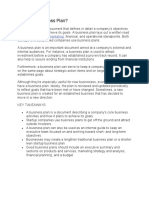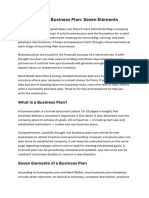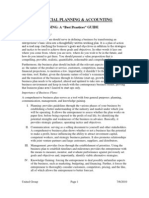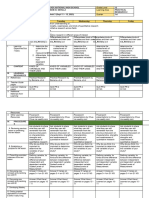0 ratings0% found this document useful (0 votes)
23 viewsBusiness Plan
Business Plan
Uploaded by
seoulmaarThe document discusses what a business plan is and provides guidance on creating an effective business plan using a free template. A business plan explains how a business will operate and make profits. It is usually created before starting a business to identify any issues that could impact profits or operations. The template outlines key elements a business plan should include such as an executive summary, company description, market analysis, marketing strategy, operational plan, financial projections, management team, and legal structure. Providing thorough details in a business plan can help reveal flaws and ensure a new business is set up for success.
Copyright:
© All Rights Reserved
Available Formats
Download as DOCX, PDF, TXT or read online from Scribd
Business Plan
Business Plan
Uploaded by
seoulmaar0 ratings0% found this document useful (0 votes)
23 views5 pagesThe document discusses what a business plan is and provides guidance on creating an effective business plan using a free template. A business plan explains how a business will operate and make profits. It is usually created before starting a business to identify any issues that could impact profits or operations. The template outlines key elements a business plan should include such as an executive summary, company description, market analysis, marketing strategy, operational plan, financial projections, management team, and legal structure. Providing thorough details in a business plan can help reveal flaws and ensure a new business is set up for success.
Copyright
© © All Rights Reserved
Available Formats
DOCX, PDF, TXT or read online from Scribd
Share this document
Did you find this document useful?
Is this content inappropriate?
The document discusses what a business plan is and provides guidance on creating an effective business plan using a free template. A business plan explains how a business will operate and make profits. It is usually created before starting a business to identify any issues that could impact profits or operations. The template outlines key elements a business plan should include such as an executive summary, company description, market analysis, marketing strategy, operational plan, financial projections, management team, and legal structure. Providing thorough details in a business plan can help reveal flaws and ensure a new business is set up for success.
Copyright:
© All Rights Reserved
Available Formats
Download as DOCX, PDF, TXT or read online from Scribd
Download as docx, pdf, or txt
0 ratings0% found this document useful (0 votes)
23 views5 pagesBusiness Plan
Business Plan
Uploaded by
seoulmaarThe document discusses what a business plan is and provides guidance on creating an effective business plan using a free template. A business plan explains how a business will operate and make profits. It is usually created before starting a business to identify any issues that could impact profits or operations. The template outlines key elements a business plan should include such as an executive summary, company description, market analysis, marketing strategy, operational plan, financial projections, management team, and legal structure. Providing thorough details in a business plan can help reveal flaws and ensure a new business is set up for success.
Copyright:
© All Rights Reserved
Available Formats
Download as DOCX, PDF, TXT or read online from Scribd
Download as docx, pdf, or txt
You are on page 1of 5
To start your business journey on the right foot, download our free business plan template and break
down your business goals into actionable components.
Before you can start your business, you need to find your niche, seek financial backing and create a
business plan to bring your idea to fruition. Our free business plan template will guide you through
every step of the way. But first, let’s quickly define what a business plan is.
What Is a Business Plan?
A business plan is a document that explains how a business will operate and establish itself in the
market to generate profits. Business plans are usually created before a new business starts, to make
sure there are no loose ends that could affect its profitability or ability to operate. They can also be
created for business improvement purposes.
Business plans are also crucial for raising funds for new business ventures, as they’re used to provide
the key details an investor should know to determine whether or not a business is a sound investment.
What Is a Business Plan Template?
Our business plan template outlines the business, product or service that you want to launch. It also
details the market you’re targeting, the goals and objectives of the venture and how you propose to
achieve them.
ProjectManager’s free business plan template for Word.
The business plan is one of the three pillars that any new idea must stand on to be successful. The
other two are a marketing plan and a financial plan. These will be touched upon in part within the
business plan template and included in full as supporting documents.
What Should Be Included In a Business Plan Template?
Business plans vary from one organization to another. However, there are key elements that any
business plan should have to provide a clear picture of a business, especially if you’re creating a
business plan to request funding from investors. Here’s an outline that includes some of the most
fundamental aspects to add to your business plans.
Executive summary
Company description
Market analysis
Marketing & sales strategy
Operational plan
Financial projections
Organizational structure and management
Legal structure
While you can decide how thorough you want your business plan to be, you’ll want to provide as
many details as possible. A detailed business plan can reveal significant flaws in your business model.
Business planning flaws such as ignoring industry trends can cost your company money, or could even
lead to bankruptcy, so it’s important that you take your time when making a business plan.
How to Use This Free Business Plan Template
Now, let’s dive into each of those sections to have a better idea of how to use this business plan
template for Word.
Executive Summary
Here’s where you lay out your idea. Your executive summary is the elevator pitch, something that
encapsulates your business plan contents in just one page or a couple of paragraphs.
The main purpose of your executive summary is to highlight the key elements from your business plan
thatyou wish to communicate to investors or stakeholders such as the market opportunity, an overview
of how you’ll manage the venture, competitive advantages, key aspects of the company background,
etc.
Company Description
This section explains what your company does and what it intends to achieve.
Mission statement: The mission statement is a short action declaration that explains the
purpose of your business and what it does. It should be one or two sentences long.
Vision statement: The vision statement is similar to your mission statement in terms of length,
but the vision statement states the future goals of the organization.
Value proposition: The value proposition explains how your company will offer value to
customers in a unique way that differentiates it from the competition.
Core values: The core values are the guiding principles that shape your company’s
organizational culture, such as integrity, innovation and collaboration.
Market Analysis
This section should explain to readers how your company intends to compete and position itself in a
particular market. To do so, you should include the following:
Industry analysis: Provide an overview of your business industry. Briefly explain if there are
any current trends that might affect your business, either positively or negatively, such as new
competitors, new technologies or any other changes. You should include statistics to explain
how your industry has grown over the years to convince stakeholders of its value.
Target market: The target market section should explain the ideal customer for your products.
Your marketing activities will be focused on this type of customer, so it should be the most
profitable customer to serve. You can easily express what your target market is by creating
buyer personas.
Direct competitors: Direct competitors are businesses that offer exactly the same type of
product you do and also serve the same target market. For this reason, you should use your
unique value proposition to differentiate from them. Think about two different brands of soda.
They offer the exact same product to the same market, at the same place.
Indirect competitors: Indirect competitors are businesses that offer substitute products to your
target market, which means they don’t offer the same product as you do, but their product
could also be used to satisfy the same customer need. Now think about butter and margarine.
While the product isn’t exactly the same, it can be purchased by customers to satisfy the same
need.
SWOT analysis: SWOT stands for strengths, weaknesses, opportunities and threats. A SWOT
analysis is a very important part of a business plan because it allows you to do a quick
assessment of your current competitive position by looking at the internal strengths and
weaknesses of your business while also considering any opportunities and threats from the
external environment, such as the risk of new competitors or the opportunity of an underserved
market.
Marketing & Sales Strategy
The purpose of this section is to explain how your company will market the product to your
customers. It uses the 4 Ps of marketing as the guiding principle.
Product: Explain what your product is, how it works and how it’s meant to be used. Also,
explain some of the main attributes or features that make it superior to other products on the
market. This can be anything such as lower production costs, durability or ease of use.
Price: Pricing is an important part of your marketing strategy. Use this template to indicate
your estimated profit margin along with a general description of the expected costs.
Place: Place simply refers to two main things. Your sales channels, which are the methods you
use to sell your product, such as online e-commerce platforms or brick-and-mortar locations
and your distribution channels, which are the methods of transportation you’ll use to bring
your product from the production line to the final customer.
Promotion: Use this section to explain the various methods you’ll use to advertise your
product, such as websites, social media platforms or traditional methods such as TV,
newspaper or radio ads.
Operational Plan
This section should provide a quick overview of how your business will operate by outlining the
following areas:
Day-to-day operations: Briefly explain how your business will serve customers or
manufacture products. The goal is to provide a quick overview of the daily operations of your
business for stakeholders and investors.
Supply chain: Every business needs to purchase raw materials, parts and components to
deliver products or services to its target market. Use this section to explain the key steps in
your supply chain, and who are your key suppliers.
Permits and regulatory compliance: Use this section to list any permits or regulatory
compliance standards your products should meet, if any.
Financial Projections
Use this section to attach any financial documents you might have. If you’re starting a new business
you can use financial forecasts. Here are some of the financial documents you can include.
Income statements
Balance sheets
Cash flow statements
Capital expenditure budgets
Cost forecasts
Gross profit projections
Profit & loss statement
Projected balance sheet
In addition to these documents, it’s advisable to include an exit strategy. The exit strategy is a
contingency plan that’s executed to minimize losses for investors and business owners in the event of
bankruptcy or if the business must be terminated at some point. Use this section to briefly explain how
you’d execute your exit strategy.
Management Team and Key Personnel
It helps to build confidence and give investors a sense of the risk they’re dealing with if you can
provide profiles of your executive and management team. In fact, anyone who will be instrumental in
executing the business plan should be included. Their skills and experience can go a long way to
realizing your business plan.
Legal Structure
Last but not least, use this section to explain whether your business is a sole proprietorship,
partnership, corporation or any other type of legal structure.
While you can decide how thorough you want your business plan to be, the more details you provide
the better, as a detailed business plan can reveal significant flaws in your business model. Business
planning flaws such as ignoring industry trends can cost your company money, or could even lead to
bankruptcy, so it’s important that you take your time when making a business plan.
Why Should You Use a Business Plan Template?
The main reason for a business plan template is to show off your idea in the best possible way to
attract investors by collecting the points that show why your business, product or service is viable.
The other reason is that nothing is possible without a plan. Launching a new business, product or
service is a project, and a project without a plan is like a boat without a rudder. It might not sink, but
it’s unlikely to get where you want it to go.
There are more detailed reasons to take the time and effort required to fill in our business plan
template. For example, a bank and investors won’t let you in the door without a business plan. The
same is true for any potential partners.
On top of that, the template provides broad strokes as to how to implement your idea. This is vitally
important if you sway your investors and need to make the plan a reality.
Once you have investors on board, you need to turn your business plan into a viable project. Project
management software like ProjectManager can help. Our Gantt charts can organize tasks, track costs,
allocate resources and more. Plus, live dashboards give you a high-level view of performance to catch
issues before they become problems. With project management software, you can plan, track and
report on everything that matters. We’ll help you make your business plan a successful venture.
You might also like
- Psoriasis Excerpts From The Edgar Cayce ReadingsDocument26 pagesPsoriasis Excerpts From The Edgar Cayce ReadingsjunghiuNo ratings yet
- How To Write A Business Plan For Raising Venture CapitalDocument10 pagesHow To Write A Business Plan For Raising Venture CapitalGladys GonzaloNo ratings yet
- A Business Plan Clearly Defines A CompanyDocument8 pagesA Business Plan Clearly Defines A Companyjassen VillacortaNo ratings yet
- Guide in The Preparation of Business Plan I. Executive SummaryDocument22 pagesGuide in The Preparation of Business Plan I. Executive SummaryGloria AsuncionNo ratings yet
- Business PlanDocument4 pagesBusiness PlanSimaahNo ratings yet
- Chapter 5 PresentationDocument35 pagesChapter 5 PresentationSabeur Dammak100% (1)
- Dbuss 205 Fundamentals of EntrepreneurshipDocument9 pagesDbuss 205 Fundamentals of EntrepreneurshipTemogo RaphutiNo ratings yet
- Business Plan For EntrepreneurDocument10 pagesBusiness Plan For EntrepreneurMary Joyce Camille ParasNo ratings yet
- What Is A Business PlanDocument4 pagesWhat Is A Business Planjoan bonabonNo ratings yet
- Business Plans Notes by Enock MarchDocument63 pagesBusiness Plans Notes by Enock MarchNyabensi EnockNo ratings yet
- Contents of Business PlanDocument5 pagesContents of Business PlanAnuj AgarwalNo ratings yet
- Lesson 3 - Entrep - The Business Plan - Week 3 - Sy 22-23 PDFDocument3 pagesLesson 3 - Entrep - The Business Plan - Week 3 - Sy 22-23 PDFCharisse Villarico BalondoNo ratings yet
- Business PlanDocument4 pagesBusiness PlanOtworot LookatakwiNo ratings yet
- Business PlanDocument17 pagesBusiness PlanSTANE GITHUNo ratings yet
- Basic Concept of Business PlanDocument10 pagesBasic Concept of Business PlanRoshiel Ann BarredoNo ratings yet
- Business Plan Guide: Objective of This GuideDocument12 pagesBusiness Plan Guide: Objective of This GuidePaul HarrisNo ratings yet
- Project On Business PlanDocument31 pagesProject On Business Planbhavesh_27No ratings yet
- Writing a Business Plan (1)Document12 pagesWriting a Business Plan (1)usmansuleiman247No ratings yet
- RIO ΓηροκομείοDocument16 pagesRIO ΓηροκομείοTassos ChionisNo ratings yet
- How To Write A Business PlanDocument12 pagesHow To Write A Business PlanfbeeharryNo ratings yet
- Parts of A Business Plan EntrepDocument5 pagesParts of A Business Plan EntrepAngie DiangsonNo ratings yet
- Bussiness Plan - Coffee ShopDocument16 pagesBussiness Plan - Coffee ShopKevin SebastianNo ratings yet
- Lean Business Plan TemplateDocument6 pagesLean Business Plan Templatelooverville.quinoNo ratings yet
- Writing The Business Plan IDG VenturesDocument9 pagesWriting The Business Plan IDG VentureswindevilNo ratings yet
- Coffee Shop Business PlanDocument16 pagesCoffee Shop Business Plansasyeda100% (3)
- BUSINESSDocument5 pagesBUSINESSJezibel MendozaNo ratings yet
- MEDICAL Healthcare Business Plan TempleteDocument17 pagesMEDICAL Healthcare Business Plan Templetemalik_saleem_akbarNo ratings yet
- The 10 Key Business Plan ComponentsDocument4 pagesThe 10 Key Business Plan ComponentsFELOMINO CAMINCENo ratings yet
- Business Plan ChispaDocument19 pagesBusiness Plan ChispaJoseNo ratings yet
- Work ImmersionDocument11 pagesWork ImmersionAngelica CadaoasNo ratings yet
- How To Write A Business Plan Seven ElementsDocument5 pagesHow To Write A Business Plan Seven Elementstasfiaruna3No ratings yet
- Research About Pitching and Components of Business PlanDocument4 pagesResearch About Pitching and Components of Business PlanMyb CrisostomoNo ratings yet
- Mid TermsDocument5 pagesMid Termsrajamashab157No ratings yet
- Prepare A Business Plan For Your Chosen Small Scale IndustryDocument6 pagesPrepare A Business Plan For Your Chosen Small Scale Industrysuryavanshivipin2709No ratings yet
- Rental Service For Event Equipment Introduce New Products/services Demand & SupplyDocument4 pagesRental Service For Event Equipment Introduce New Products/services Demand & SupplyShelley AndersonNo ratings yet
- Busines S Plan: NI Star SolutionsDocument22 pagesBusines S Plan: NI Star Solutionsmattaster4972No ratings yet
- Business Plan GuideDocument3 pagesBusiness Plan GuideAnonymous I03Wesk92No ratings yet
- What Is A Business Plan?Document4 pagesWhat Is A Business Plan?Drx Mehazabeen KachchawalaNo ratings yet
- Entrepreneurship Q1 - Module 2 Business PlanDocument3 pagesEntrepreneurship Q1 - Module 2 Business Planguinajn89No ratings yet
- Business Plan FormatDocument5 pagesBusiness Plan FormatErwin MatunanNo ratings yet
- Structure of The Business PlanDocument31 pagesStructure of The Business PlanHercules ConnectNo ratings yet
- Sample Bus Plan 3Document18 pagesSample Bus Plan 3bplo odionganNo ratings yet
- Business Plan TemplateDocument5 pagesBusiness Plan TemplateJoão Carlos CastroNo ratings yet
- Business Plan and Its Features or ElementsDocument5 pagesBusiness Plan and Its Features or ElementsSaleh RehmanNo ratings yet
- 7 Essential Elements of A Business PlanDocument2 pages7 Essential Elements of A Business Planminorona2409No ratings yet
- Business Plan Template: Step-by-Step Guide To Writing Your OwnDocument11 pagesBusiness Plan Template: Step-by-Step Guide To Writing Your OwnZelalem JemereNo ratings yet
- Business Plan Format Guide VrushaliDocument10 pagesBusiness Plan Format Guide Vrushalisatish4647No ratings yet
- Business Development Plan - Venture Capitalists Perspective, Networking, Evaluation, Plan Lecture Series 21 & 22Document22 pagesBusiness Development Plan - Venture Capitalists Perspective, Networking, Evaluation, Plan Lecture Series 21 & 22Amit BarmanNo ratings yet
- Components of A Business PlanDocument3 pagesComponents of A Business Plancandy lollipoNo ratings yet
- Pure A: Business Plan For "Business Name"Document7 pagesPure A: Business Plan For "Business Name"arcelio emiyaNo ratings yet
- Entrepreneurship Development Chapter-4Document16 pagesEntrepreneurship Development Chapter-4Bobby MNo ratings yet
- Business PlanDocument3 pagesBusiness PlanAnji JoguilonNo ratings yet
- Formatting Your Business PlanDocument11 pagesFormatting Your Business PlanKAYE AIRA DE LEONNo ratings yet
- Guidelines To Business Plan 1Document6 pagesGuidelines To Business Plan 1mohamedNo ratings yet
- Creating A Business Plan CanDocument4 pagesCreating A Business Plan CanИсламNo ratings yet
- Business Plan: Executive SummaryDocument19 pagesBusiness Plan: Executive SummaryAngela HernandezNo ratings yet
- AdditionalDocument4 pagesAdditionalWasim NaveedNo ratings yet
- Financial Planning & Accounting: Business Planning: A "Best Practices" GuideDocument13 pagesFinancial Planning & Accounting: Business Planning: A "Best Practices" GuideNoor HassanNo ratings yet
- How To Write A Business PlanDocument4 pagesHow To Write A Business PlandaveNo ratings yet
- 1NOTESDocument5 pages1NOTESDavison Davis NsingoNo ratings yet
- Cinematography Basics: I Year (Integrated)Document12 pagesCinematography Basics: I Year (Integrated)raviitherising0% (1)
- Manual de Servicio MB460 - 470 - 480 - MM - Rev2 PDFDocument247 pagesManual de Servicio MB460 - 470 - 480 - MM - Rev2 PDFErick MarzNo ratings yet
- WinnerDocument26 pagesWinnerNguyễn Tấn PhátNo ratings yet
- The Electrical Worker May 2010Document20 pagesThe Electrical Worker May 2010Kathryn R. ThompsonNo ratings yet
- Hentai Sim Brothel Strategy Guide PDFDocument2 pagesHentai Sim Brothel Strategy Guide PDFAnanda GautamaNo ratings yet
- Soict2023 - E2EE For Cross-Platform ApplicationsDocument5 pagesSoict2023 - E2EE For Cross-Platform ApplicationsDũng Đỗ TiếnNo ratings yet
- Thesis & Dissertations: - Definition - Getting Started - ContentsDocument9 pagesThesis & Dissertations: - Definition - Getting Started - Contentsniizam77No ratings yet
- PR2 DLL - Week 3Document4 pagesPR2 DLL - Week 3nedieNo ratings yet
- Ansno1 Business Environment Introduction To BusinessDocument27 pagesAnsno1 Business Environment Introduction To BusinesskalimodakNo ratings yet
- Application Tables - Starter Pages & Examples - Preline UI, Crafted With Tailwind CSSDocument14 pagesApplication Tables - Starter Pages & Examples - Preline UI, Crafted With Tailwind CSSMaximeNo ratings yet
- 2022 - LLB202 - Week 3 Tutorial QuestionsDocument10 pages2022 - LLB202 - Week 3 Tutorial QuestionsWill Lawrence (ChoirBoy)No ratings yet
- Me Myself & Identity Online - Identity Salience On Facebook Vs NDocument101 pagesMe Myself & Identity Online - Identity Salience On Facebook Vs NRoxanne MendezNo ratings yet
- Digestive System of A FrogDocument14 pagesDigestive System of A FrogLoida Gigi AbanadorNo ratings yet
- Help For 22 Years From InternetDocument130 pagesHelp For 22 Years From InternetChiamaka AngelaNo ratings yet
- Bharti Axa Life InsuranceDocument75 pagesBharti Axa Life InsuranceShahbazHasanNo ratings yet
- Research Plan IMRAD Helpful TipsDocument83 pagesResearch Plan IMRAD Helpful TipsSteffanNo ratings yet
- Boettinger Et Al - 2002 - Phase-Field Simulation of SolidificationDocument38 pagesBoettinger Et Al - 2002 - Phase-Field Simulation of SolidificationDanilo CurtolloNo ratings yet
- Bill 3Document1 pageBill 3Yogesh GhogaleNo ratings yet
- Accounting Diffusion Theory Approach (P3+4) - Dàn ÝDocument4 pagesAccounting Diffusion Theory Approach (P3+4) - Dàn ÝQuang Minh NguyễnNo ratings yet
- Memorandum: Tabuk City Fire StationDocument7 pagesMemorandum: Tabuk City Fire StationJanine Blaize Oplay CaniwNo ratings yet
- Local Media7859961281233592821Document24 pagesLocal Media7859961281233592821Jude CajesNo ratings yet
- What Font To Use For PHD ThesisDocument8 pagesWhat Font To Use For PHD Thesisafbtabxds100% (1)
- About TESCO EquipmentsDocument24 pagesAbout TESCO EquipmentsfilbryantNo ratings yet
- Tax Invoice/Bill of Supply/Cash Memo: (Original For Recipient)Document1 pageTax Invoice/Bill of Supply/Cash Memo: (Original For Recipient)RMNo ratings yet
- SSD Symbols Template and InstructionsDocument14 pagesSSD Symbols Template and InstructionsAriane grace TacadenaNo ratings yet
- How To Avoid Varus Stem in THRDocument6 pagesHow To Avoid Varus Stem in THRPoliceNo ratings yet
- Republic Act No. 7611 Strategic Environmental Plan (SEP) For Palawan ActDocument3 pagesRepublic Act No. 7611 Strategic Environmental Plan (SEP) For Palawan ActElvira Baconga NeriNo ratings yet























































































